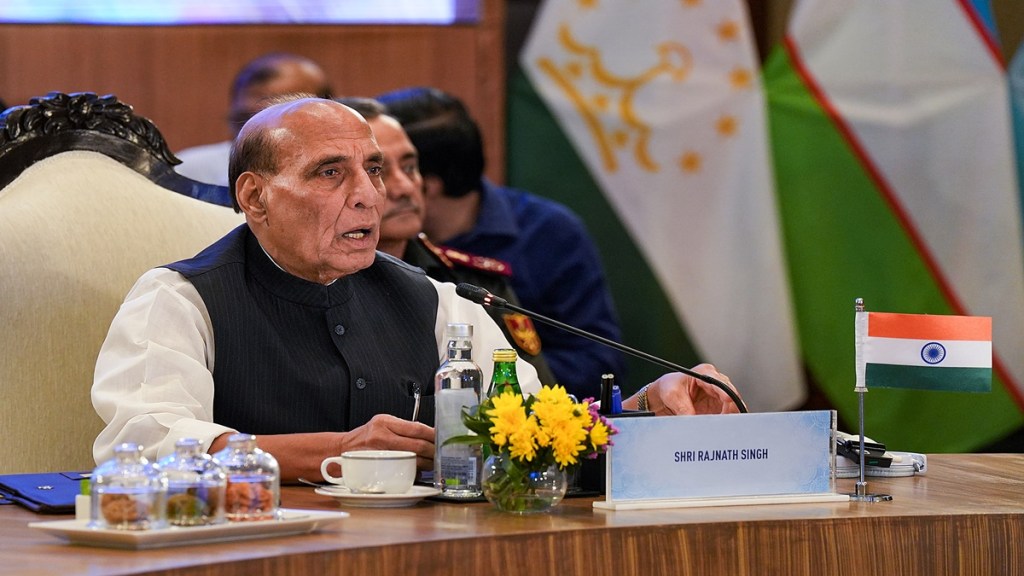By N Chandra Mohan
India’s defence minister Rajnath Singh’s meeting with his Chinese counterpart, General Li Shangfu, on the sidelines of the Shanghai Cooperation Organisation meeting of defence ministers in New Delhi exemplifies the limited progress on the standoff on the Sino-Indian border since April 2020 that has bedevilled relations between the two nations. While Singh forcefully stated that Sino-Indian relations were premised on peace and tranquillity on the border; the social media read out of the Chinese statement was that the situation on the border was generally stable. According to Singh, the violation of existing border agreements has eroded the entire basis of bilateral relations. China held that both sides should take a long-term view and place the border situation in an appropriate position in bilateral relations.
The stakes involved for India are huge as it has been forced to deploy more Army divisions to match China’s massive build-up on the line of actual control. As has been pointed out by strategic affairs experts like Col Ajai Shukla, both nations share a disputed 2,100-mile border which has neither been marked on a map nor marked out on the mountainous terrain. There have been protocols in place, especially after Prime Minister Rajiv Gandhi’s visit to China in 1988. Both sides inked an agreement in 1993, followed by four more pacts, for restraint and joint action to maintain peace on the border. But all of this is history now with the bloody clashes that erupted in 2020 and later as well. De-escalation and disengagement are off for now despite 18 rounds of India-China military commander meetings.
As the border situation remains fragile, the big question is whether it is business as usual for bilateral ties? India would like to believe it is not although the fact remains that it has not been able to impose severe costs on the dragon for its border transgressions. Consider foreign investments and trade, for instance, Since April 2020, India has intensified the screening of foreign direct investment proposals from neighbouring countries obviously targeting China. A proximate trigger was the People’s Bank of China purchasing shares in HDFC, taking its stake above 1% for $100 million in March 2020. The Indian government has received about 54 foreign direct investment proposals from China since, which are pending for approval as on March 21, 2023, according to the Union finance minister.
But the Chinese continue to invest after April 2020. Tencent acquired a 1% holding in Walmart for $260 million in June 2022. Even if some like MG Motors India have faced restrictions, they have found a way to step up investments through local partners. MG Motors is a subsidiary of SAIC Motor Company, which acquired a 50% stake in General Motors India in 2009, and took over its car facility in Gujarat in 2017 to roll out SUVs for the domestic market. To secure the necessary resources for modernising its plant and introduce newer models, MG Motors is in talks with the JSW Group which could result in the latter taking a 10-15% holding in the company according to Business Line. A ball park estimate of Chinese investments in India from March 2007 till June 2022 is $16.65 billion, according to American Enterprise Institute’s China global investment tracker.
Post 2020, there has been no diminishing dependence on trade with China either. The dragon remains one of our largest trade partners, with two-way trade of $104 billion in FY23 (till February). China remains the largest source of our imports with a share of 13.8% while only 3.3% of our exports are headed to the mainland. The trade balance is heavily tilted against India with a ballooning trade deficit of $77 billion. India’s dependence on the dragon appears more akin to a Third World country that exports raw materials while importing manufactured goods from the mainland. The fact China can inundate our domestic market with cheaper electronic goods and components, chemicals, thanks to surplus capacities is a major reason why India opted out of the Regional Comprehensive Economic Partnership.
Unfortunately, there are no easy solutions for the fraught border situation. Over the long haul, it can be resolved by narrowing the economic power differential between India and China. Much is being made of India replacing the UK to become the world’s fifth-largest economy, but China is six times larger as the second-largest economy. This is reflected in relative military strength, with India in a disadvantageous position to resolve the issue through force. India must steadily build up its economy through rapid growth to narrow this differential while balancing China in the short run through its strategic alliances with the Quad countries. By amassing troops and making border incursions at will, China recognises India only as a weaker neighbour, not as one with whom it can define the Asian century.
(The writer is an economics and business commentator based in New Delhi. His views are personal)

